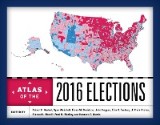Details

Atlas of the 2016 Elections
|
104,99 € |
|
| Verlag: | Rowman & Littlefield Publishers |
| Format: | |
| Veröffentl.: | 22.01.2018 |
| ISBN/EAN: | 9781538104231 |
| Sprache: | englisch |
| Anzahl Seiten: | 280 |
DRM-geschütztes eBook, Sie benötigen z.B. Adobe Digital Editions und eine Adobe ID zum Lesen.
Beschreibungen
<span><span>The 2016 presidential election was one of the most dramatic upsets in US political history. Virtually all pre-election polls indicated Democrat Hillary Clinton ahead of Republican Donald Trump in the popular vote and Electoral College. The </span><span>Atlas of the 2016 Elections</span><span> explains the surprising Trump victory with a series of unique maps unleashing the illustrative power of cartography and the explanatory power of history and political geography. The contributors—a balanced mix of geographers, political scientists, and historians—provide a comprehensive examination of the entire gamut of the election process from the primary campaigns and nominating conventions to the fall campaign and final results. In addition to the presidential election, the </span><span>Atlas</span><span> has full coverage of other important races, including United States Senate and House of Representatives, state races, and local and state referendum. Illustrated with over 100 meticulously drawn full-color maps, the</span><span> Atlas</span><span> will be an essential reference and a fascinating resource for pundits, voters, campaign staffs, and political junkies alike.</span></span>
<span>The 2016 election was one of the most dramatic upsets in US history. Explaining the surprising Trump victory, leading scholars trace the entire gamut of the election. Illustrated with over 100 full-color maps, the atlas will be an essential reference and a fascinating resource for pundits, voters, campaign staffs, and political junkies.</span>
<span><span>List of Figures and Tables<br>Preface<br>Chapter 1: Introduction<br></span><span>Robert H. Watrel and Erin K. Fouberg</span><span><br>Chapter 2: Primary Elections<br>The 2016 Presidential Primary Campaigns <br></span><span>Fred M. Shelley and Ashley M. Hitt </span><span><br>2016 Presidential Primaries: Michigan <br></span><span>Lisa M. DeChano-Cook</span><span><br>Chapter 3: The Campaign<br>The 2016 Campaign<br></span><span>John Heppen</span><span><br>Donorsheds: Individual Contributions to Clinton and Trump<br></span><span>Carl T. Dahlman</span><span><br>Campaign Expenditures in the 2016 Election<br></span><span>Chris Maier </span><span><br>Campaign Stops<br></span><span>J. Clark Archer and Jill A. Archer</span><span><br>Place Name Use in the 2016 Presidential Debates<br></span><span>Matthew Balentine and Gerald R. Webster</span><span><br>Vote Fraud or Vote Suppression: The Debate Before and After the 2016 Election<br></span><span>Richard L. Engstrom</span><span><br>Newspaper Endorsements of Presidential Candidates in the 2016 Election<br></span><span>Lindy Westenhoff and Gerald R. Webster</span><span><br>Misogyny, Twitter, and the Rural Voter<br></span><span>Monica Stephens, Li Tong, Scott Hale and Mark Graham</span><span><br>Chapter 4: Outcomes <br>Results of the 2016 Presidential Election at the State and County Levels<br></span><span>Fred M. Shelley, John Heppen and Richard L. Morrill</span><span><br>Voter Participation<br></span><span>Chris Maier</span><span><br>Statistical Analysis of the 2016 Election in Historical Perspective<br></span><span>Fred M. Shelley, Robert H. Watrel and J. Clark Archer</span><span><br>Spatial Analysis of the 2016 Election <br></span><span>John Heppen</span><span><br>Metropolitan Concentration of the Democratic Vote<br></span><span>Richard L. Morrill and Jason Combs</span><span><br>The 2016 Presidential Vote: The Rural Vote<br></span><span>Jeff Crump</span><span><br>Micropolitan County Voting<br></span><span>Jason Combs</span><span><br>Flipped Counties in the 2016 Election <br></span><span>Jason Combs</span><span><br>An Increasingly Polarized America?<br></span><span>Ron Johnston, Kelvyn Jones and David Manley</span><span><br>Election Outcomes: Absolute and Relative <br></span><span>Richard L. Morrill and Kimberly K. Johnson</span><span><br>Chapter 5: Regions<br>Northeast<br></span><span>William Berentsen</span><span><br>Appalachia <br></span><span>Ken C. Martis</span><span><br>Southeast<br></span><span>Jonathan I. Leib</span><span><br>Midwest <br></span><span>John Heppen</span><span><br>Great Plains <br></span><span>Robert H. Watrel</span><span><br>Mountain West<br></span><span>Tony Robinson</span><span><br>Pacific <br></span><span>John Agnew</span><span><br>Chapter 6: Demographics and Identity<br>Population Subgroups<br></span><span>Richard L. Morrill</span><span><br>Hispanic Voting Trends and Issues in the 2016 Presidential Election <br></span><span>Ryan Weichelt</span><span><br>Asian American Vote <br></span><span>Daniel McGowin</span><span><br>Gender and Voting in the 2016 Election<br></span><span>Fiona Davidson</span><span><br>Religion and the 2016 U.S. Presidential Election <br></span><span>Fred M. Shelley</span><span><br>Bible Belt <br></span><span>Gerald R. Webster and Daniel McGowin</span><span><br>Trump, Brexit and the Global Revolt of the “Left Behind” <br></span><span>Ron Johnston, David Manley and Kelvyn Jones</span><span><br>Chapter 7: Congressional Elections and Roll Call Votes<br>Membership, Party, and Caucuses in the 114th Congress <br></span><span>Erin H. Fouberg</span><span><br>114th Congress Roll-Call Votes <br></span><span>Erin H. Fouberg</span><span><br>Overview of the 2016 Senate Elections <br></span><span>Ryan Weichelt</span><span><br>2016 Wisconsin Senate Election <br></span><span>Kenneth French</span><span><br>2016 Minnesota 2</span><span><sup>nd</sup></span><span> Congressional District Election <br></span><span>Samuel Loftsgaarden</span><span><br>Symbiotic Elections: The 2016 Arizona Senate and 1</span><span><sup>st</sup></span><span> Congressional District <br></span><span>Levi John Wolf</span><span><br>Obamacare and the 2016 Election <br></span><span>Ryan Weichelt</span><span><br>Chapter 8: State Elections, Local Elections and Referenda<br>Persistence and Change in State and Local Elections <br></span><span>Richard L. Morrill</span><span><br>Missouri Gubernatorial Election 2016 <br></span><span>Matthew Engel</span><span><br>Seattle’s 2013 Vote on Election of Council by District <br></span><span>Richard L. Morrill and Ben Anderstone</span><span><br>Montana 2016: Conservativism vs. Contrarianism? <br></span><span>Larry Knopp</span><span><br>North Carolina Gubernatorial Election, 2016 <br></span><span>Katie Weichelt</span><span><br>How Laquan McDonald's Shooting “Shook” up the Cook County State's Attorney Election<br></span><span>Megan A. Gall and Jennifer L. Patin</span><span><br>Comparison of 2012 and 2016 Presidential Results for Wisconsin Voting Districts<br></span><span>Ryan Weichelt</span><span><br>Marijuana Legalization Votes in 2016 <br></span><span>Richard L. Morrill and Larry Knopp</span><span><br>Precinct Level Analysis in Washington: Minimum Wage versus the Presidency <br></span><span>Ben Anderstone and Richard L. Morrill</span><span><br>Chapter 9: The 2016 Election and Beyond<br></span><span>J. Clark Archer, Robert H. Watrel, Fiona Davidson, Erin H. Fouberg, Kenneth C. Martis, Richard L. Morrill, Fred M. Shelley, and Gerald R. Webster</span><span><br>Index</span></span>
<span><span>Robert H. Watrel is associate professor of geography at South Dakota State University. <br>Ryan Weichelt is associate professor of geography at the University of Wisconsin–Eau Claire.<br>Fiona Davidson is associate professor of geography at the University of Arkansas.<br>John Heppen is professor of geography at the University of Wisconsin–River Falls.<br>Erin H. Fouberg is professor of geography at Northern State University.<br>J. Clark Archer is professor of geography at the University of Nebraska–Lincoln.<br>Richard L. Morrill is emeritus professor of geography at the University of Washington.<br>Fred M. Shelley is professor of geography at the University of Oklahoma.<br>Kenneth C. Martis is emeritus professor of geography at West Virginia University.</span></span>
<p><span>6/1/2020: Booklist feature article “Core Collection: Voting and Election Reference Resources” features book. </span></p>
<p><span>Link: <a href="https://www.booklistonline.com/Core-Collection-Voting-and-Election-Reference-Resources-Maguire-Susan/pid=9735278"><span>https://www.booklistonline.com/Core-Collection-Voting-and-Election-Reference-Resources-Maguire-Susan/pid=9735278</span></a></span></p>
<p></p>
<p><span>Link: <a href="https://www.booklistonline.com/Core-Collection-Voting-and-Election-Reference-Resources-Maguire-Susan/pid=9735278"><span>https://www.booklistonline.com/Core-Collection-Voting-and-Election-Reference-Resources-Maguire-Susan/pid=9735278</span></a></span></p>
<p></p>
Diese Produkte könnten Sie auch interessieren:

Economía y Política en el Ecuador de los setenta: el comienzo del espejismo petrolero.

von: Augusto de la Torre Endara, Jorge A. Hidrobo Estrada, José Vicente Zevallos López, Bertha J. García Gallegos

5,49 €















